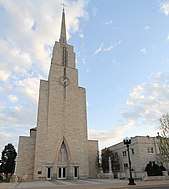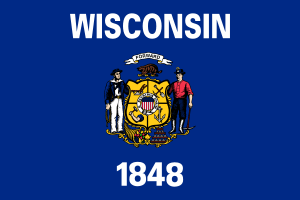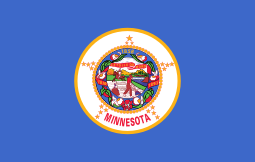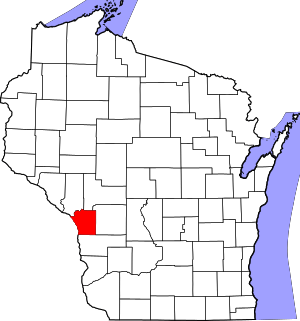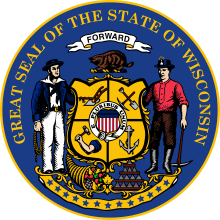La Crosse, Wisconsin
La Crosse is a city in the U.S. state of Wisconsin and the county seat of La Crosse County. Positioned alongside the Mississippi River, La Crosse is the largest city on Wisconsin's western border.[6] La Crosse's estimated population in 2019 was 51,227.[7] The city forms the core of and is the principal city in the La Crosse Metropolitan Area, which includes all of La Crosse County and Houston County, Minnesota, for a population of 135,298.[8]
La Crosse | |
|---|---|
City | |
| City of La Crosse | |
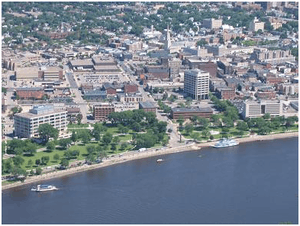 Downtown La Crosse | |
 Seal | |
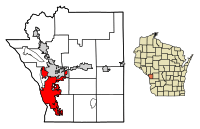 Location of La Crosse in La Crosse County, Wisconsin. | |
| Coordinates: 43°48′48″N 91°13′59″W | |
| Country | |
| State | |
| County | La Crosse |
| Government | |
| • Type | Mayor-council government |
| • Mayor | Tim Kabat (D) |
| Area | |
| • City | 23.79 sq mi (61.61 km2) |
| • Land | 21.70 sq mi (56.21 km2) |
| • Water | 2.08 sq mi (5.40 km2) |
| Elevation | 669 ft (204 m) |
| Population | |
| • City | 51,320 |
| • Estimate (2019)[3] | 51,227 |
| • Rank | US: 609th |
| • Density | 2,360.36/sq mi (911.34/km2) |
| • Urban | 100,868 (US: 298th) |
| • Metro | 136,934 (US: 297th) |
| Time zone | UTC−6 (Central) |
| • Summer (DST) | UTC−5 (Central) |
| Zip Code | 54601, 54602, 54603 |
| Area code | 608 |
| FIPS code | 55-40775[4] |
| GNIS feature ID | 1567672[5] |
| Airports | La Crosse Regional Airport |
| Interstate | I-90 |
| Website | cityoflacrosse |
A regional technology, medical, education, manufacturing, and transportation hub, companies based in the La Crosse area include Organic Valley, Logistics Health Incorporated, Kwik Trip, La Crosse Technology, City Brewing Company, and Trane. La Crosse is a college town and home to the University of Wisconsin-La Crosse, Viterbo University, and Western Technical College.
History
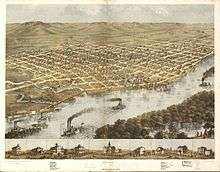
The first Europeans to see the site of La Crosse were French fur traders who traveled the Mississippi River in the late 17th century. There is no written record of any visit to the site until 1805, when Lt. Zebulon Pike mounted an expedition up the Mississippi River for the United States. Pike recorded the location's name as "Prairie La Crosse". The name originated from the game with sticks that resembled a bishop's crozier or la crosse in French, which was played by Native Americans there.[9][10]
The first white settlement at La Crosse occurred in 1841 when Nathan Myrick, a New York native, moved to the village at Prairie du Chien, Wisconsin to work in the fur trade. Myrick was disappointed to find that because many fur traders were already well-entrenched there, there were no openings for him in the trade. As a result, he decided to establish a trading post upriver at the then still unsettled site of Prairie La Crosse. In 1841, he built a temporary trading post on Barron Island (now called Pettibone Park), which lies just west of La Crosse's present downtown. The following year, Myrick relocated the post to the mainland prairie, partnering with H. J. B. Miller to run the outfit.[11]
The spot Myrick chose to build his trading post proved ideal for settlement. It was near the junction of the Black, La Crosse, and Mississippi Rivers. In addition, the post was built at one of the few points along the Wisconsin side of the Mississippi River where a broad plain ideal for development existed between the river's bank and the tall bluffs that line the river valley. Because of these advantages, a small village grew around Myrick's trading post in the 1840s.
A small Mormon community settled at La Crosse in 1844, building several dozen cabins a few miles south of Myrick's post. Although these settlers relocated away from the Midwest after just a year, the land they occupied near La Crosse continues to bear the name Mormon Coulee.[12]
On June 23, 1850, Father James Lloyd Breck of the Episcopal Church said the first Christian liturgy on top of Grandad Bluff.[13] Today a monument to that event stands atop the bluff, near the parking lot at a scenic overlook.
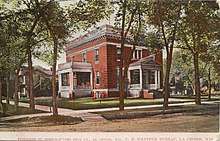
More permanent development took place closer to Myrick's trading post, where stores, a hotel, and a post office were constructed during the 1840s. Under the direction of Timothy Burns, lieutenant governor of Wisconsin, surveyor William Hood platted the village in 1851. This opened it up for further settlement, which was achieved rapidly as a result of promotion of the city in eastern newspapers. By 1855, La Crosse had grown in population to nearly 2,000 residents, leading to its incorporation in 1856. The city grew even more rapidly after 1858 with the completion of the La Crosse & Milwaukee Railroad, the second railroad connecting Milwaukee to the Mississippi River.
During the second half of the 19th century, La Crosse grew to become one of the largest cities in Wisconsin.[14] It was a center of the lumber industry, for logs cut in the interior of the state could be rafted down the Black River toward sawmills built in the city. La Crosse also became a center for the brewing industry and other manufacturers that saw advantages in the city's location adjacent to major transportation arteries, such as the Mississippi River and the railroad between Milwaukee and St. Paul, Minnesota. Around the turn of the 20th century, the city also became a center for education, with three colleges and universities established in the city between 1890 and 1912.
In 2016, Mayors Tim Kabat and John Medinger issued a proclamation apologizing for La Crosse's history as a sundown town that discriminated against African Americans.[15]
La Crosse remains the largest city on Wisconsin's western border, and the educational institutions in the city have recently led it toward becoming a regional technology and medical hub.
Geography
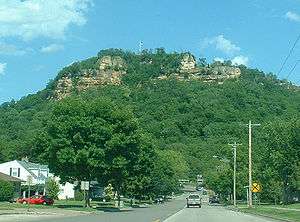
La Crosse is located on the western border of the midsection of Wisconsin, on a broad alluvial plain along the east side of the Mississippi River. The Black River empties into the Mississippi north of the city, and the La Crosse River flows into the Mississippi just north of the downtown area. Just upriver from its mouth, this river broadens into a marshland that splits the city into two distinct sections, north and south.
According to the United States Census Bureau, the city has a total area of 22.54 square miles (58.38 km2), of which, 20.52 square miles (53.15 km2) is land and 2.02 square miles (5.23 km2) is water.[16]
Surrounding the relatively flat prairie valley where La Crosse lies are towering 500 ft bluffs, one of the most prominent of which is Grandad Bluff (mentioned in Life on the Mississippi by Mark Twain), which has an overlook of the three states region. This feature typifies the topography of the Driftless Area in which La Crosse sits. This rugged region is composed of high ridges dissected by narrow valleys called coulees, a French term. As a result, the area around La Crosse is frequently referred to as the "Coulee Region".
Climate
La Crosse's location in the United States' upper midwest gives the area a temperate, continental climate.[17] The warmest month of the year is July, when the average high temperature is 84.1 °F (28.9 °C), with overnight low temperatures averaging 63.2 °F (17.3 °C). January is the coldest month, with high temperatures averaging 25.9 °F (−3.4 °C), with the overnight low temperatures around 8.9 °F (−12.8 °C).[18]
| Climate data for La Crosse Regional Airport, Wisconsin (1981–2010 normals,[19] extremes 1872–present) | |||||||||||||
|---|---|---|---|---|---|---|---|---|---|---|---|---|---|
| Month | Jan | Feb | Mar | Apr | May | Jun | Jul | Aug | Sep | Oct | Nov | Dec | Year |
| Record high °F (°C) | 57 (14) |
65 (18) |
84 (29) |
93 (34) |
107 (42) |
102 (39) |
108 (42) |
105 (41) |
101 (38) |
93 (34) |
80 (27) |
67 (19) |
108 (42) |
| Mean maximum °F (°C) | 45.4 (7.4) |
50.5 (10.3) |
69.0 (20.6) |
82.2 (27.9) |
87.8 (31.0) |
93.6 (34.2) |
95.7 (35.4) |
94.0 (34.4) |
89.2 (31.8) |
80.6 (27.0) |
64.0 (17.8) |
48.1 (8.9) |
97.7 (36.5) |
| Average high °F (°C) | 25.9 (−3.4) |
31.4 (−0.3) |
43.9 (6.6) |
59.3 (15.2) |
70.7 (21.5) |
80.0 (26.7) |
84.1 (28.9) |
81.5 (27.5) |
73.2 (22.9) |
59.9 (15.5) |
43.8 (6.6) |
29.1 (−1.6) |
57.0 (13.9) |
| Average low °F (°C) | 8.9 (−12.8) |
13.6 (−10.2) |
25.2 (−3.8) |
37.9 (3.3) |
48.7 (9.3) |
58.5 (14.7) |
63.2 (17.3) |
61.3 (16.3) |
52.4 (11.3) |
40.4 (4.7) |
28.1 (−2.2) |
14.2 (−9.9) |
37.8 (3.2) |
| Mean minimum °F (°C) | −13.8 (−25.4) |
−10.4 (−23.6) |
3.9 (−15.6) |
21.7 (−5.7) |
34.1 (1.2) |
44.6 (7.0) |
51.5 (10.8) |
49.3 (9.6) |
36.5 (2.5) |
25.4 (−3.7) |
12.0 (−11.1) |
−8.7 (−22.6) |
−18.4 (−28.0) |
| Record low °F (°C) | −43 (−42) |
−36 (−38) |
−28 (−33) |
7 (−14) |
26 (−3) |
33 (1) |
44 (7) |
35 (2) |
24 (−4) |
6 (−14) |
−21 (−29) |
−37 (−38) |
−43 (−42) |
| Average precipitation inches (mm) | 1.12 (28) |
1.05 (27) |
2.04 (52) |
3.34 (85) |
3.52 (89) |
4.34 (110) |
4.26 (108) |
4.29 (109) |
3.56 (90) |
2.17 (55) |
2.01 (51) |
1.36 (35) |
33.06 (840) |
| Average snowfall inches (cm) | 10.7 (27) |
8.2 (21) |
7.1 (18) |
1.7 (4.3) |
0 (0) |
0 (0) |
0 (0) |
0 (0) |
0 (0) |
0.2 (0.51) |
4.1 (10) |
11.3 (29) |
43.3 (110) |
| Average precipitation days (≥ 0.01 in) | 9.1 | 8.0 | 9.8 | 11.2 | 11.9 | 11.5 | 10.4 | 9.8 | 9.6 | 9.3 | 9.0 | 9.2 | 118.8 |
| Average snowy days (≥ 0.1 in) | 7.8 | 6.4 | 4.3 | 1.2 | 0 | 0 | 0 | 0 | 0 | 0.3 | 3.1 | 7.0 | 30.1 |
| Source: NOAA[20][21] | |||||||||||||
Neighborhoods and districts
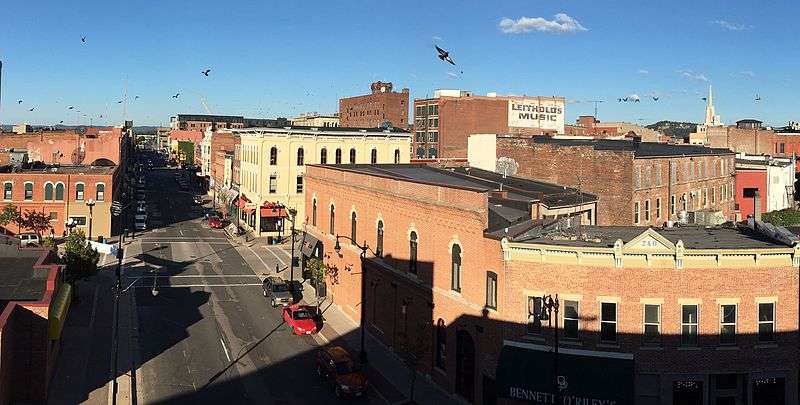
La Crosse has 13 voting districts (wards).[22] Neighborhoods in the city include:
- Washburn
- Historic Cass & King
- Powell-Poage-Hamilton[23]
- Historic downtown
- Northside (Upper and Lower) and Old Towne
- Grandview Emerson
- Weigent Hogan
- Hintgen
- College Park (UW–La Crosse campus district)
- Springbrook Clayton Johnson
Suburbs include French Island in the Town of Campbell, Holmen, the Town of Medary, City of Onalaska, La Crescent, Minnesota, and the Town of Shelby.
Demographics
| Historical population | |||
|---|---|---|---|
| Census | Pop. | %± | |
| 1860 | 3,860 | — | |
| 1870 | 7,785 | 101.7% | |
| 1880 | 14,505 | 86.3% | |
| 1890 | 25,000 | 72.4% | |
| 1900 | 28,895 | 15.6% | |
| 1910 | 30,417 | 5.3% | |
| 1920 | 30,421 | 0.0% | |
| 1930 | 39,614 | 30.2% | |
| 1940 | 42,707 | 7.8% | |
| 1950 | 47,535 | 11.3% | |
| 1960 | 47,258 | −0.6% | |
| 1970 | 50,286 | 6.4% | |
| 1980 | 48,347 | −3.9% | |
| 1990 | 51,140 | 5.8% | |
| 2000 | 51,818 | 1.3% | |
| 2010 | 51,320 | −1.0% | |
| Est. 2019 | 51,227 | [3] | −0.2% |
| U.S. Decennial Census[24] 2018 Estimate[25] | |||
According to 2013–2018 ACS estimates, the median household income was $43,516 and the median family income was $59,461. Males had a median income of $40,772 versus $33,325 for females. The per capita income for the city was $21,282. About 10.1% of families and 23.3% of the population were below the poverty line, including 19.7% of those under age 18 and 7.8% of those age 65 or over.[26]
2010 census
At the 2010 census,[27] there were 51,320 people, 21,428 households and 9,691 families residing in the city. The population has density was 2,501.5 per square mile (965.6/km²). There were 22,628 housing units at an average density of 1,102.7 per square mile (425.8/km²). The racial makeup of the city was 89.8% White, 2.3% African American, 0.6% Native American, 4.9% Asian, 0.0% Pacific Islander, 0.4% from other races, and 2.1% from two or more races. Hispanic or Latino of any race were 2.0% of the population.
There were 21,428 households of which 19.5% had children under the age of 18 living with them, 31.6% were married couples living together, 9.7% had a female householder with no husband present, and 54.8% were non-families. 37.7% of all households were composed of individuals and 11.7% had someone living alone who was 65 years of age or older. The average household size was 2.18 and the average family size was 2.86.
16.2% of the population were under the age of 18, 26.5% from 18 to 24, 23.1% from 25 to 44, 21.0% from 45 to 64, and 13.1% who were 65 years of age or older. The median age was 30 years. For every 100 females, there were 89.0 males. For every 100 females age 18 and over, there were 89.4 males.
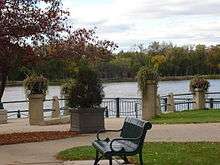
Economy
La Crosse is the home and current global headquarters of several corporations and organizations, including:
- Allergy Associates of La Crosse and Allergychoices, Inc., national allergy clinic and allergy services organization serving patients and providers across the U.S..
- Altra Federal Credit Union, La Crosse based credit union servicing eight states across the country[28]
- City Brewing Company, former Heileman Old Style brewery[29]
- Mayo Clinic Health System – Franciscan Healthcare, regional health care network with flagship campus in La Crosse
- Gundersen Health System, nonprofit comprehensive health care network with flagship campus in La Crosse[30]
- Kwik Trip, regional gas and convenience stores[31]
- La Crosse Technology, atomic clocks and weather stations
- Marine Credit Union, credit union with branches in Wisconsin, Minnesota, and Iowa
Corporations founded and formerly headquartered in La Crosse include:
- Cargill, America's now largest privately held corporation founded in La Crosse[32]
- LaCrosse Footwear, footwear company founded in 1897[33]
- Trane, international air conditioning, acquired by Ingersoll-Rand in 2008[34]
Largest employers
As of 2012 the 10 largest employers in La Crosse were:[35]
- Gundersen Health System
- Mayo Clinic Health System – Franciscan Healthcare
- Trane
- Kwik Trip
- La Crosse County
- School District of La Crosse
- University of Wisconsin–La Crosse
- Logistics Health Incorporated
- City of La Crosse
- Western Technical College
Shopping
La Crosse and the surrounding communities form a regional commercial center and shopping hub. In the northeastern region of the city lies the area's largest shopping center, Valley View Mall. The surrounding area includes numerous big-box stores, and many restaurants. Other shopping centers in the La Crosse region include Three Rivers Plaza, Marsh View Center, Shelby Mall, Jackson Plaza, Bridgeview Plaza, and the Village Shopping Center. Downtown La Crosse has experienced significant growth in recent years, providing shopping, farmers' markets, hotels, restaurants, specialty shops, and events at La Crosse Center on the Mississippi River.[36]
Convention Center
The La Crosse Center is a 10,000 seat multi-purpose indoor arena built in 1980 in downtown La Crosse on the Mississippi River. It is also a convention center offering 21,600 square feet (2,010 m2) of exhibit space, a 45-foot (14 m) ceiling height, a 60-by-40-foot stage, two locker rooms and three dressing rooms. There is also a 14,935-square-foot (1,388 m2) North Hall which can open up to be used in combination with the arena, and a 38,740-square-foot (3,599 m2) South Exhibit Hall. The three venues total 75,275 square feet (6,993 m2) of exhibit space. The complex also contains 9,432 square feet (876 m2) of meeting room space in five meeting rooms, which can be divided into nine meeting rooms.[37]
While both exhibit halls and the arena are used for trade shows, conventions, meetings and banquets, the arena is also used for sporting events, concerts, circuses, ice shows, and other events.
Culture
La Crosse has over 30 active arts organizations.[38] The Pump House Regional Arts Center hosts visual arts exhibits throughout the year plus its own series of jazz, folk, and blues performers. The La Crosse Symphony is the city's regional orchestra and the La Crosse Community Theater has won both regional and national acclaim. The city is home to the Blue Stars Drum & Bugle Corps, a member of Drum Corps International. Other arts sites include Viterbo University Fine Arts building, UW–La Crosse Art Gallery and Theater, and the La Crosse Center, which hosts national performers.[39][40] Local sculptor Elmer Petersen has created sculptures that are exhibited throughout the downtown area, including La Crosse Players and the Eagle in Riverside Park.[41]
Bars and clubs
La Crosse has many bars and nightclubs in the downtown central business district, as well as many neighborhood bars and grills.[42]
Annual events
- La Crosse Oktoberfest
- La Crosse Riverfest
- St. Elias Mediterranean Festival
- Freedom Fest
- Midwest Banjo Fest
- Irish Fest
- Wienerfest
- Firecracker Four Mile
- Artspire La Crosse
- Great River Folk Festival
- La Crosse Mardi Gras
- Downtown Cameron Park Farmers Market
- Historic Downtown La Crosse Days
- Winter Rec Fest
- New Year's Eve Celebration with The Skyrockers
- Hmong New Year Parade
- Rotary Lights Display
- La Crosse Labor Day Parade and Celebration
- La Crosse Storytelling Festival
- Beer Wine and Cheese Fest
Sports
The La Crosse Loggers of the Northwoods League, play baseball at their home field at Copeland Park on the north side of La Crosse in the summer months.[43] In 2017, the La Crosse Showtime began play in the American Basketball Association at La Crosse Center. In the past, the La Crosse Center has been home to the Catbirds and the Bobcats of the CBA, as well as the River Rats of the IFL, the Spartans of the IFL and the Night Train of the NIFL.
La Crosse is also home to the NCAA Division III University of Wisconsin–La Crosse (UW–L) Eagles. The university's 10,000 seat Veterans Memorial Field for football (turf field) and outdoor timed track opened in 2009. The stadium will continue to host the WIAA Wisconsin high school outdoor track and field state championships in June.[44][45]
In the winter season, the Coulee Region Chill is a junior team in the North American 3 Hockey League at the Green Island Ice Arena.[46] Additionally, Mt. La Crosse, the area's only ski hill, which opened in 1959, provides 18 slopes and trails. The ski hill is home to Damnation!, Mid-America's steepest trail.[47]
The La Crosse Fairgrounds Speedway, located in nearby West Salem, is the first and only paved NASCAR-sanctioned asphalt stock car racing track in Wisconsin.[48]
Hunting and fishing are very popular all seasons of the year, and the Mississippi and other rivers, sloughs, creeks, lakes, the Upper Mississippi River Wildlife Refuge, and hilltops and valleys with public woodlands are available to sportsmen and families.
Riverside Park

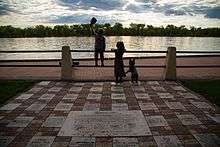
Riverside Park is situated on the riverfront of downtown La Crosse near the Blue Bridges and across the river from Pettibone Park. It hosts events such as Riverfest, Fourth of July fireworks, Oktoberfest, and the Rotary Lights. The steamboats American Queen, La Crosse Queen, and Julia Belle Swain make stops along the river in the park. It is a home to many statues, including a large statue of a Native American.[49] The statue is based on Hiawatha, the 16th-century chief who is credited with bringing together the Iroquois Nation.[50] There is public debate about whether this statue is offensive to Native Americans.[51] The park has walking/running trails.[52]
Government and politics
The city government employs a weak mayor form of the mayor-council system. The mayor is elected at-large, while the 13 members of the Common Council are elected per aldermanic districts.[53] The mayor is Tim Kabat, a progressive.[54]
Both the city and county of La Crosse have voted Democratic in every presidential election since 1988.[55] In the 2016 Presidential Election, Hillary Clinton won by 52% of the City of La Crosse. In the 2012 presidential election, Barack Obama won 65% of the city of La Crosse[56] and 58% of La Crosse County.[57] In 2014, the Milwaukee Journal Sentinel ranked La Crosse as one of Wisconsin's top performing Democratic cities.[58]
In the United States Congress, Democrat Ron Kind has represented La Crosse as part of Wisconsin's 3rd congressional district since 1997. The city is almost coterminous with the 95th Wisconsin State Assembly District and is represented by Democrat Jill Billings. Additionally, Democrat Steve Doyle currently represents suburban La Crosse County in the 94th Assembly District. La Crosse is part of the State Senate District 32 and is represented by Democrat Jennifer Shilling.
Mayors
Source:[59]
- Thomas Benton Stoddard (1856)
- Erasmus D. Campbell (1857)
- David Taylor (1858)
- James I. Lyndes (D) (1859)
- John M. Levy (1860)
- Wilson Colwel (1861)
- A. W. Pettibone (1862–1864)
- W. J. Lloyd (1865)
- John M. Levy (1866–1867)
- Theodore Rodolf (1868)
- Charles. L. Colman (1869)
- Theodore Rodolf (1870)
- Alexander McMillan (1871)
- James I. Lyndes (1872)
- Gysbert Van Steenwyk, Sr. (1873–1874)[60]
- Gilbert M. Woodward (1874–1875)[60]
- James J. Hogan (1875–1876)
- George Edwards (1877)
- David Law (1878–1879)
- Joseph Clark (1880)
- H. F. Smiley (1881)
- David Law (1882–1883)
- W. A. Roosevelt (1884)
- D. Frank Powell (1885–1886)
- David Austin (1887–1888)
- John Dengler (1889–1890)
- F. A. Copeland (1892)[60]
- D. Frank Powell (1893–1896)
- James McCord (1897–1898)
- W. A. Anderson (1899–1900)
- Joseph Boschert (1901–1902)
- William Torrance (1903–1906)
- Ori J. Sorenson (1909–1910)[61]
- Arthur A. Bentley (1915–1923)[62]
- Henry J. Ahrens (1950–1955)[60]
- Milo Knutson (1955–1965)[63]
- Warren Loveland (1965–1971)[64]
- W. Peter Gilbertson (1971–1975)
- Patrick Zielke (April 20, 1975 – April 15, 1997)[65]
- John Medinger (April 15, 1997 – April 19, 2005)
- Mark Johnsrud (April 19, 2005 – April 21, 2009)
- Mathias Harter (April 21, 2009 – April 16, 2013)
- Tim Kabat (April 16, 2013 – present)[66]
Education
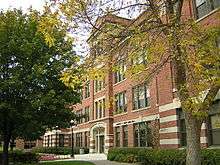
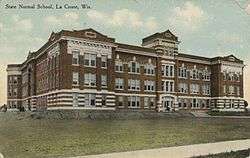
The La Crosse area is served by the School District of La Crosse, with an enrollment of 6,632 students in 2017,[67][68] making it the 16th largest school district in the state. The district has 19 elementary, middle, high and charter schools.[68] La Crosse Central High School and Logan High School are the two public high schools serving the La Crosse area. The La Crosse School District has 631 teachers.[68]
Catholic private schools in La Crosse include La Crosse Aquinas Catholic Schools, a Roman Catholic school district affiliated with the Diocese of La Crosse, which is centered in the city and includes Aquinas High School and Aquinas Middle School.[69] Another Roman Catholic school, the Providence Academy, is independent from the district and has no affiliation with the Diocese.[70]
Lutheran private schools in La Crosse include First Lutheran School, Immanuel Lutheran School, and Mt. Calvary-Grace Lutheran School, which are part of the La Crosse Area Lutheran Schools organization and affiliated with the Wisconsin Evangelical Lutheran Synod. Luther High School is in Onalaska, Wisconsin.[71]
La Crosse is the home of three regional colleges and universities, the public University of Wisconsin–La Crosse, Western Technical College, and the Roman Catholic Viterbo University. The Health Science Center is a combined effort of all the La Crosse medical centers, universities and government agencies to advance students in the medical fields.[72]
Awards and rankings
- 2002 – National Trust for Historic Preservation Great American Main Street Award[73]
- 2003 - Milken Institute Best Performing Cities of the 96 Smallest Metros (20th Overall)[74]
- 2005 – Inc. magazine's 4th Best Small City for Doing Business[75]
- 2005 – Inc. magazine's 15th Best City in America to Do Business[76]
- 2005 – Forbes 25th Best Place[77]
- 2006 – 7th Safest Metropolitan Area in the Nation – Morgan Quitno Press[78]
- 2006 – Kiplinger's Personal Finance ranked La Crosse 16th "Smartest Place to Live in U.S.[79]
- 2007 – Country Home magazine ranked La Crosse 12th Best Green City in America and second among small cities, behind Corvallis, Ore.[80]
- 2009 – U.S. News ranked La Crosse one of the 10 best places to live in the country.[81]
- 2009 – Farmers Insurance Group ranked La Crosse – Winona, Minnesota area the 20th most secure place to live in the United States among small towns.[82]
- 2010 – Most Secure Places to Live in the US (Small Towns) – Sperling's Best Places[83]
- 2014 – 42nd in the Forbes list of Best Small Places for Business and Careers;[6] and ranked 11th on Outside magazine's 16 Best Places to Live in the U.S.[84]
- 2018 – Matador Network ranked La Crosse 16th in its list of The 25 Coolest Towns in America.[85]
Media
Print
La Crosse's largest newspaper is the daily La Crosse Tribune which serves the Wisconsin, Minnesota, and Iowa regions. Free weekly tabloids include the Foxxy Shopper and the Buyer's Express. The Racquet is the University of Wisconsin-La Crosse's free weekly paper.
Coulee Parenting Connection is a magazine serving families in the La Crosse area. Coulee Region Women is a magazine serving the community.
Television
| Channel | Callsign | Affiliation | Branding | Subchannels | Owner | |
|---|---|---|---|---|---|---|
| (Virtual) | Channel | Programming | ||||
| 8.1 | WKBT | CBS | WKBT 8 | 8.2 8.3 8.4 8.5 8.6 |
MyNetworkTV ION Dabl QVC HSN |
Morgan Murphy Media |
| 10.1 | KTTC | NBC | KTTC 10 | 10.3 | Heroes & Icons | Quincy Newspapers |
| 13.1 | WEAU | NBC | WEAU 13 News | 13.2 13.3 13.4 |
Antenna TV Heroes & Icons Movies! |
Gray Television |
| 19.1 | WXOW | ABC | WXOW 19 | 19.2 19.3 19.4 19.5 |
CW Decades Court TV Justice Network |
Quincy Newspapers |
| 23.1 | KQEG | AMGTV (part-time) |
KQEG-TV 23/51/Cable 5 | Magnum Radio, Inc. | ||
| 25.1 | WLAX | FOX | FOX 25/48 | 25.2 25.3 25.4 |
MeTV Laff Grit |
Nexstar Media Group |
| 31.1 | WHLA | PBS | PBS Wisconsin | 31.2 31.3 31.4 |
Wisconsin Channel Create PBS Kids |
Wisconsin Educational Communications Board |
AM radio
| FM radio stations | ||||
|---|---|---|---|---|
| Frequency | Call sign | Name | Format | Owner |
| 580 AM | WKTY | Sports | Family Radio, Inc. | |
| 1410 AM | WIZM | News talk 1410 | News/Talk | Family Radio, Inc. |
| 1490 AM | WLFN | Today's Talk 1490 | Talk | Mississippi Valley Broadcasters, LLC |
| 1560 AM | WKBH | Relevant Radio | Catholic | Starboard Media Foundation, Inc. |
FM radio
| FM radio stations | ||||
|---|---|---|---|---|
| Frequency | Call sign | Name | Format | Owner |
| 88.1 FM | K201BW (KZSE Translator) | MPR News | NPR | Minnesota Public Radio |
| 88.9 FM | WLSU | Wisconsin Public Radio | Classic | Wisconsin Public Radio |
| 90.3 FM | WHLA | Wisconsin Public Radio | NPR | Wisconsin Public Radio |
| 91.1 FM | KXLC | Minnesota Public Radio | NPR | Minnesota Public Radio |
| 91.9 FM | K220EP (KFSI Translator) | KFSI 92.9 | Christian | Faith Sound Incorporated |
| 92.3 FM | K222AG (WIZM-AM Translator) | News talk 1410 | News/Talk | Family Radio, Inc. |
| 93.3 FM | WIZM | Z93.3 | Top 40 (CHR) | Family Radio, Inc. |
| 93.7 FM | K229BH (WWIB Translator) | 103.7 WWIB | Christian | Stewards of Sound, Inc. |
| 94.1 FM | W231DL (WKBH-AM Translator) | Relevant Radio | Catholic | Starboard Media Foundation, Inc. |
| 94.5 FM | WTMB | Classic Rock 94.5 | Classic rock | Magnum Radio, Inc. |
| 94.7 FM | KCLH | Classic Hits 94.7 | Classic Hits | Family Radio, Inc. |
| 95.7 FM | WRQT | 95.7 The Rock | Active Rock | Family Radio, Inc. |
| 96.1 FM | WXYM | Mix 96.1 | Hot AC | Magnum Radio, Inc. |
| 96.7 FM | K244FM (WKTY-AM Translator) | Sports | Family Radio, Inc. | |
| 97.1 FM | WCOW | Cow 97.1 Country | Country | Sparta-Tomah Broadcasting Co., Inc. |
| 97.9 FM | K250AZ (WTPN Translator) | The Prayz Network | Christian | The Salvation Poem Foundation, Inc. |
| 98.9 FM | WVCX | VCY America | Christian | VCY America |
| 100.1 FM | WKBH | Classic Rock 100.1 | Classic rock | Mississippi Valley Broadcasters, LLC |
| 101.1 FM | KRIV | Soft Rock 101.1 | Soft AC | Leighton Radio Holdings, Inc. |
| 101.9 FM | K270AG (WFBZ Translator) | 105.5 ESPN | Sports | Sparta-Tomah Broadcasting Co., Inc |
| 102.7 FM | KQEG | Eagle 102.7 | Oldies | Mississippi Valley Broadcasters, LLC |
| 104.9 FM | WLXR | Magic 105 | Adult contemporary | Mississippi Valley Broadcasters, LLC |
| 105.5 FM | WFBZ | 105.5 ESPN | Sports | Sparta-Tomah Broadcasting Co., Inc. |
| 106.3 FM | WQCC | Kicks 106.3 | Country | Mississippi Valley Broadcasters, LLC |
| 107.3 FM | W297CT (WXYM Translator) | Mix 96.1 | Hot AC | Magnum Radio, Inc. |
| 107.7 FM | W299AC (KQYB Translator) | KQ98 | Country | Family Radio, Inc. |
Infrastructure
Transportation
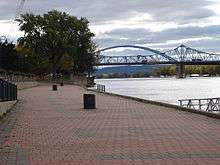
The La Crosse Regional Airport, located on French Island, provides direct scheduled passenger service to Minneapolis, Detroit, and Chicago through Delta Air Lines link Endeavor Air, as well as American Airlines link Envoy Air. Sun Country and Xtra Airways provide charter service to Laughlin, Elko, Nevada, and other destinations. The airport also serves general aviation for the La Crosse region.[86]
The city is served by several major highways and Interstate, including Interstate 90, U.S. Highway 14, U.S. Highway 53, U.S. Highway 61, Wisconsin State Highway 35, Wisconsin State Highway 16, Wisconsin State Highway 33.
The Mississippi River Bridge, also known as the Cass St. bridge and the newer Cameron Street bridge (photo with blue arch) both connect downtown La Crosse with La Crescent, Minnesota. These two bridges cross the Mississippi River, as does the Interstate 90 bridge located just northwest of La Crosse, connecting Wisconsin and Minnesota.
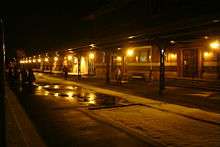
In 2012, the City of La Crosse was the first city in Wisconsin to pass a Green Complete Streets ordinance. This ordinance requires that when roads are reconstructed the needs of stormwater management and the safety of bicycles and pedestrians are taken into account in the new design.
The City of La Crosse's MTU bus service with routes reaching out to the suburbs served over one million users in 2007.[87]
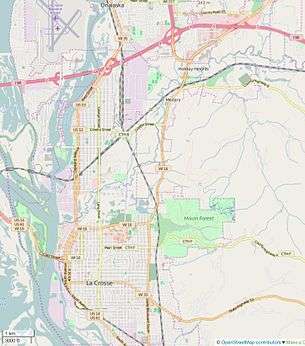
On the Mississippi River, cargo is transported to and from this area to St Paul and St Louis, using towboats, primarily moving dry bulk cargo barges for coal, grain, and other low-value bulk goods.
Railroad tracks owned by Burlington Northern and Santa Fe Railway (BNSF) pass through La Crosse providing freight service. The former Milwaukee and La Crosse Railroad/Milwaukee Road/Soo Line and now Canadian Pacific Railway runs through the city as well. It provides the track on which the La Crosse Amtrak station is located, served daily by the Empire Builder between Chicago and Seattle or Portland.
Water
La Crosse's tap drinking water, which is raised from a deep underground Artesian aquifer, won the best natural tasting water award in September 2007 in a statewide tasting competition hosted by the Wisconsin Water Association. The city competed against groundwater and surface water utilities from Algoma, Appleton, Green Bay, Madison, Milwaukee, Pell Lake, Shawano, Shawano Lake and Watertown at the annual meeting of the association. La Crosse's drinking water is pumped from deep ground wells to a distribution center and is treated with chlorine and fluoride; some wells are also treated with polyphosphate.
Health care
Two major regional health care facilities are located in La Crosse: Gundersen Health System and Mayo Clinic Health System - Franciscan Healthcare.
Gundersen Health System is a nationally ranked health care system located in La Crosse that is also an ACS nationally certified Level II Trauma Center. It is the primary hospital associated with the Gundersen Clinic medical group and the location of the Western campus for the University of Wisconsin Medical School. With its main campus located in La Crosse, the system also manages 23 locations throughout Wisconsin, Minnesota and Iowa with nearly 6,000 employees.[88][89] In 2014, Gundersen Health received the Healthgrades America's 50 Best Hospitals™ designation, placing the system among the top 1 percent of hospitals nationwide.[90]
Mayo Clinic Health System - Franciscan Healthcare is an affiliate of the Mayo Clinic. Franciscan Skemp, which was the first western Wisconsin hospital to open its doors in 1883 as St. Francis Hospital, was started by the Catholic Franciscan Sisters of Perpetual Adoration, who still are associated with the medical center. In 1995, Franciscan Skemp merged with Mayo Clinic Health Systems in Rochester, Minnesota, located only 60 miles away. A new trauma and emergency department, helicopter pad, and surgery wing recently opened in 2007.[91]
The Health Science Center, located on the University of Wisconsin–La Crosse campus, is a combined effort of both medical centers, UW–La Crosse, Viterbo University, Western College, the School District of La Crosse, and various government educational groups. The purpose was to prepare and train students for advancement in the medical field.[92]
Gallery of historic places
Buildings, sites, structures, districts, and objects in La Crosse listed on the National Register of Historic Places
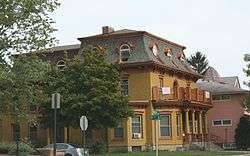
 E.R. Barron Building
E.R. Barron Building.jpg) Bridge No. 1
Bridge No. 1.jpg) Bridge No. 2
Bridge No. 2.jpg) Bridge No. 3
Bridge No. 3.jpg)
.jpg) Bridge No. 6
Bridge No. 6- Chicago, Milwaukee and Saint Paul Railway Passenger Depot
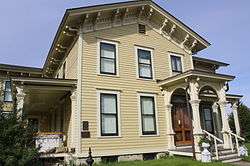

- Laverty-Martindale House
- Losey Memorial Arch

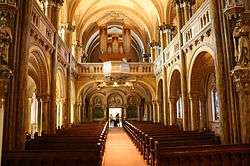
- Will Ott House
- Our Lady of Sorrows Chapel
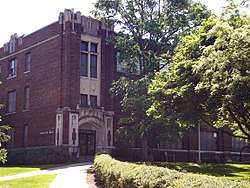 Physical Education Building/La Crosse State Normal School
Physical Education Building/La Crosse State Normal School- Powell Place
- W. A. Roosevelt Company
- Smith Valley School
- U.S. Fish Control Laboratory
- James Vincent House
- Waterworks Building
- Wisconsin Telephone Company Building
- George Zeisler Building
Notable people
- George Addes, founder of United Auto Workers
- John Ake, professional baseball player
- Wendell Abraham Anderson, Chairman of the Democratic Party of Wisconsin
- Stuart P. Baker, U.S. Navy Rear Admiral
- Elmer E. Barlow, Wisconsin Supreme Court justice
- Charles S. Benton, U.S. Representative from New York
- Raymond Bice, Sr., businessman, state representative and senator
- Fred Biermann, U.S. Representative from Iowa
- Harriet Bossnot, social and civic worker
- Thea Bowman, Roman Catholic, religious sister and educator
- Ruth Boynton, physician and educator
- Orville Buckner, professional boxer
- Raymond Burke, Cardinal Prefect of the Vatican's Supreme Tribunal of the Apostolic Signatura
- Timothy Burns, Lieutenant Governor of Wisconsin
- Chris Bury, Nightline correspondent
- Ole Amundsen Buslett, author
- Angus Cameron, U.S. Senator
- James Cameron, civil rights activist
- Erasmus D. Campbell, Lieutenant Governor of Wisconsin
- William Wallace Cargill, founder of Cargill
- Ebenezer Childs, Territorial legislator
- Russell G. Cleary, president of the G. Heileman Brewing Company
- Frank P. Coburn, U.S. Representative
- Elijah Fox Cook, Michigan and Wisconsin State Senators
- George Dahlgren, NFL player
- Charles G. Dawes, Vice President of the United States
- Alexa Demara, model, actress
- James Devitt, Wisconsin legislator
- Charles Dierkop, actor
- Chip Dunham, cartoonist
- John S. Durland, Wisconsin State Representative
- John J. Esch, U.S. Representative
- Bob Fitzke, NFL player
- Paul Fitzke, baseball player
- Connor Franta, YouTuber.
- George A. Garrett, U.S. diplomat
- Ed Gein, Serial killer and grave robber
- Tony Ghelfi, MLB player
- Lawrence R. Gibson, Wisconsin State Representative
- Gerald Greider, Wisconsin State Representative
- Adolph Gundersen, physician
- Tom Hanneman, sports broadcaster
- Hal Hanson, NFL player and head coach
- Gottlieb Heileman, founder of G. Heileman Brewing Company
- Sylvester John Hemleben, poet, writer and academic
- Gideon Hixon, businessman, state representative and senator
- Chuck Hockenbery, MLB player
- Clark L. Hood, Wisconsin State Representative and lawyer
- Wayne J. Hood, Executive Director of the Republican National Committee
- Merlin Hull, U.S. Representative
- William Hull, lawyer and legislator[93]
- Hugo Jan Huss, orchestra conductor
- Don Iverson, professional golfer
- Stephen Jerzak, professional musician
- Matt Joyce, NFL player
- John Azor Kellogg, U.S. military leader and state senator
- Mark Kellogg, reporter (killed at the Battle of the Little Bighorn)
- Ron Kind, United States House of Representatives
- Tom Klawitter, MLB player
- Charles E. Knoblauch, Iowa state representative
- Milo Knutson, mayor of La Crosse and state senator
- Bronson Koenig, basketball player
- Ed Konetchy, MLB player
- Edward C. Krause, Wisconsin State Representative
- Arthur Kreutz, composer
- Robert E. Kreutz, composer
- Carl Kurtenecker, Wisconsin State Representative[94]
- Ty Loomis, volleyball player
- Joseph Losey, film and theater director
- Patrick Joseph Lucey, Governor of Wisconsin, U.S. diplomat
- James T. McCleary, U.S. Representative from Minnesota
- John H. MacMillan Sr, businessman, President of Cargill[95]
- Helen Adelia Manville, poet, litterateur
- Paul Marcotte, businessman and former member of the Kentucky House of Representatives
- John Medinger, former Mayor of La Crosse and former member of the state assembly
- John Mengelt, NBA player
- Curt Michel, NASA astronaut, professor
- Damian Miller, MLB player
- Robert Moevs, composer (1920–2007)
- Thomas Morris, Lieutenant Governor of Wisconsin[96]
- Leland E. Mulder, member of the state assembly
- John Mulder, state representative
- Eddie Murphy, Olympic medalist
- Henry Nein, Wisconsin legislator
- Tom Newberry, NFL all-pro offensive guard
- Mike O'Callaghan, Governor of Nevada
- Paul Offner, member of the state assembly and senate
- John Oestreicher, lawyer and member of the state assembly
- Jim Omerberg, member of the West Virginia House of Delegates
- Charles M. Palmer, organizer of the Associated Press
- John Joseph Paul. Roman Catholic bishop
- Oscar S. Paulson, Wisconsin legislator
- George Wilbur Peck, newspaper publisher, humorist, mayor of Milwaukee, Governor of Wisconsin
- James D. H. Peterson, member of the state assembly
- Augustus Herman Pettibone, U.S. Representative from Tennessee
- George Poage, Olympic medalist, first African American to win an Olympic medal
- Marcus M. Pomeroy, editor of the La Crosse Democrat newspaper during the Civil War
- Marion Manville Pope, poet, author, world traveler, philanthropist
- Brandon Ratcliff, actor
- Nicholas Ray, film and theater director (1911–1979, a.k.a. Raymond Nicholas Kienzle)
- Edwin W. Rice, President of General Electric
- Walter Ristow, librarian
- Glen Selbo, NBA player, selected second overall in 1947 NBA Draft
- Scott Servais, MLB player
- Philip Saunders, NBA coach
- Rudolph Schlabach, lawyer and legislator
- John Shuman, Army Distinguished Service Medal recipient
- Frank Skaff, MLB player and manager
- Freddie Slack, musician and bandleader
- Thomas Benton Stoddard, first mayor of La Crosse; member of the state assembly
- Ford Sterling, actor
- William H. Stevenson, U.S. Representative
- Woodrow Swancutt, U.S. Air Force Major General
- Jim Temp, NFL player
- Clark W. Thompson, U.S. Representative from Texas
- John Toland, Pulitzer Prize-winning author
- Clarence Tommerson, NFL player
- James Trane, co-founder of Trane
- Reuben Trane, co-founder of Trane
- Danielle Trussoni, author
- Dave Umhoefer, Pulitzer Prize-winning journalist
- Dolly Vanderlip, All-American Girls Professional Baseball League player
- Gysbert Van Steenwyk, Sr., businessman, Mayor of La Crosse, member of the state assembly and senate
- D. Russell Wartinbee, educator and member of the state assembly
- Cadwallader C. Washburn, Civil War General, Wisconsin Governor, U.S. House
- Jarrod Washburn, Major League Baseball Player, Detroit Tigers, Los Angeles Angels of Anaheim
- John Wilce, member of the College Football Hall of Fame
- George Williams, MLB player
- Levi Withee, lumberman and Wisconsin state senator
- Gardner R. Withrow, U.S. Representative
- Gilbert Motier Woodward, U.S. Representative
Religion
Catholic
La Crosse is the episcopal see for the Roman Catholic Diocese of La Crosse. The Cathedral of Saint Joseph the Workman is the mother church of the Diocese. St. Rose of Viterbo Convent, the mother house of the Franciscan Sisters of Perpetual Adoration is in La Crosse. The Shrine of Our Lady of Guadalupe is in La Crosse. Commissioned by Cardinal Raymond Burke while he was Bishop of La Crosse, it was designed by architect Duncan Stroik.
Protestant
Protestant churches include Lutheran, Baptist, Methodist, Vineyard, Presbyterian, and independent.
The Wisconsin Evangelical Lutheran Synod has five churches in La Crosse: First Lutheran Church,[97] Grace Lutheran Church,[98] Immanuel Lutheran Church,[99] Mt. Calvary Lutheran Church,[100] and St. John's Lutheran Church.[101]
Anglican
Christ Church of La Crosse, the city's Episcopal church, is listed on the National Register of Historic Places.
Orthodox
St. Elias Antiochian Orthodox Church is the city's Eastern Orthodox Church.
Jewish
The Congregation Sons of Abraham is in La Crosse.
Unitarian Universalist
The Unitarian Universalist Fellowship of La Crosse has held services since 1951.[102]
Muslim
Islamic Society Othman Bin Afaan is the city's Islamic mosque.
Sister cities
La Crosse has sister city relationships with seven foreign towns and cities:





- Kumbo, Cameroon

See also
- City Brewing Company
- G. Heileman Brewing Company
- La Crosse area radio stations
- La Crosse area television stations
- Old Style Beer
- Pettibone Park (La Crosse)
References
- "2019 U.S. Gazetteer Files". United States Census Bureau. Retrieved August 7, 2020.
- "U.S. Census website". United States Census Bureau. Retrieved January 2, 2013.
- "Population and Housing Unit Estimates". United States Census Bureau. May 24, 2020. Retrieved May 27, 2020.
- "U.S. Census website". United States Census Bureau. Retrieved January 31, 2008.
- "US Board on Geographic Names". United States Geological Survey. October 25, 2007. Retrieved January 31, 2008.
- "The Best Small Places For Business And Careers: La Crosse, WI". Forbes. October 24, 2017. Retrieved December 27, 2017.
- "U.S. Census Bureau QuickFacts: La Crosse city, Wisconsin". www.census.gov.
- "Metropolitan and Micropolitan Statistical Areas". Archived from the original on March 17, 2013. Retrieved May 29, 2014.
- Wisconsin Historical Society. La Crosse: Origin of La Crosse, Wisconsin. Retrieved October 24, 2017.
- Diary of Zebulon Pike, September 12, 1805, in Elliott Coues, The Expeditions of Zebulon Montgomery Pike, Vol. 1. New York: Harper, 1895, pp. 49-51.
- La Crosse County History: Brief History of La Crosse County, 1841-1905. La Crosse Public Library. Archived October 13, 2007, at the Wayback Machine
- Mormons in Wisconsin
- Charles Breck, ed. (1883). The Life of the Reverend James Lloyd Breck, D.D. Project Canterbury. New York: E. & J. B. Young.
- "La Crosse". visitbluffcountry.com. Retrieved 2018-11-06.
- Vian, Jourdan (December 11, 2016). "La Crosse mayors acknowledge city's inequitable past". Star Tribune. Minneapolis. p. B8 – via Newspapers.com.
The proclamation came a little over a month after Kabat apologized for La Crosse's history as a 'sundown town,' a city or village with either formal or informal codes that pushed black people out of the community after sundown, after a presentation from sociologist James Loewen at La Crosse City Hall. Loewen was invited by the University of Wisconsin-La Crosse and the city's Human Rights Commission.
- "US Gazetteer files 2010". United States Census Bureau. Archived from the original on January 12, 2012. Retrieved November 18, 2012.
- "Wisconsin State Climatology Office". University of Wisconsin. 2006. Retrieved November 5, 2006.
- "Monthly Averages for La Crosse, WI". The Weather Channel. 2011. Retrieved November 4, 2006.
- Mean monthly maxima and minima (i.e. the expected highest and lowest temperature readings at any point during the year or given month) calculated based on data at said location from 1981 to 2010.
- "NOWData – NOAA Online Weather Data". National Oceanic and Atmospheric Administration. Retrieved March 9, 2018.
- "Station Name: WI LA CROSSE MUNI AP". National Oceanic & Atmospheric Administration. Retrieved March 9, 2018.
- http://cityoflacrosse.org/DocumentView.asp?DID=182%5B%5D
- "Powell-Poage-Hamilton Neighborhood - La Crosse, WI". City of La Crosse. Archived from the original on January 13, 2018. Retrieved April 28, 2018.
- United States Census Bureau. "Census of Population and Housing". Retrieved November 2, 2014.
- "Population Estimates". United States Census Bureau. Retrieved June 8, 2018.
- U.S. Census Bureau. "American FactFinder". Archived from the original on 2020-02-12. Retrieved 2015-01-11.
- U.S. Census website. United States Census Bureau. Retrieved 2011-11-03.
- "Why Altra?". Altra Federal Credit Union. Archived from the original on 2015-04-10. Retrieved 2018-12-03.
- "La Crosse". City Brewing Company.
- "Our System - Gundersen Health System". www.gundersenhealth.org.
- "Our Story". Retrieved April 28, 2018.
- "Our History - Cargill". www.cargill.com.
- Mike Tighe (August 24, 2012). "LaCrosse Footwear still in former workers' hearts". La Crosse Tribune. Retrieved December 27, 2017.
- "TRANE Our History". www.trane.com. Archived from the original on 2016-01-14. Retrieved 2012-09-10.
- "Largest Employers (La Crosse County)". La Crosse Tribune. September 1, 2013. Retrieved December 27, 2017.
- Steve Cahalan (December 28, 2014). "Year in preview: Business leaders see more growth in 2015". La Crosse Tribune. Retrieved December 27, 2017.
- "The La Crosse Center". Retrieved November 4, 2006.
- "Viterbo University: Fine Arts Center History". Viterbo University Fine Arts Center. Archived from the original on April 29, 2018. Retrieved April 28, 2018.
- Pump House Regional Arts Center.
- "Staff: La Crosse Community Theatre". La Crosse Community Theatre.
- Parlin, Geri (September 6, 2008). "Elmer at 80: Hand Petersen the welding torch — there's more art to create". La Crosse Tribune. Retrieved July 26, 2014.
- "100 South 3rd Street, La Crosse, WI". Main Street Development Company. Archived from the original on 2012-03-25. Retrieved 2011-06-20.
- "La Crosse Loggers - Makin' Memories... One Game at a Time!". La Crosse Loggers.
- "Investing in our Facilities: UW-L Veterans Memorial Field Sports Complex". University of Wisconsin-La Crosse. Archived from the original on April 30, 2011. Retrieved June 11, 2011.
- "Calendar". University of Wisconsin-La Crosse Athletics.
- "Coulee Region Chill sold and relocated to Chippewa Falls, Wisconsin". North American Hockey League. April 30, 2018.
- "About Mt. La Crosse". Mt. La Crosse Skiing and Snowboarding. Archived from the original on February 3, 2011. Retrieved June 11, 2011.
- "LaCrosse Fairgrounds Speedway FAQ". La Crosse Speedway. Archived from the original on January 25, 2010. Retrieved January 10, 2010.
- "Hiawatha Statue". Roadside America. Retrieved July 10, 2018.
- "Hometown Icon: Hiawatha Statue". La Crosse Tribune. August 27, 2014. Retrieved October 18, 2018.
- "City Leaders meet about Hiawatha Satue". WEAU News 13. Retrieved July 10, 2018.
- "Riverside Park". City of La Crosse. Archived from the original on April 29, 2018. Retrieved April 28, 2018.
- "Elected Officials". City of La Crosse. Archived from the original on July 11, 2010. Retrieved March 9, 2010.
- "Council's New Gang of 5 Seek Mood of Cooperation at City Hall". WXOW. Archived from the original on 2014-02-24. Retrieved 2018-12-03.
- "Wisconsin presidential election results, 1964 to 2008". Milwaukee Journal Sentinel. November 4, 2008. Retrieved April 7, 2009.
- "Official Canvas 2012 November General La Crosse Wisconsin November 6, 2012". Retrieved April 28, 2018.
- Politico Online. "Politico Wisconsin 2012 Election Results". Retrieved January 9, 2015.
- Craig Gilbert (December 3, 2014). "The reddest and bluest places in Wisconsin". Milwaukee Journal Sentinel. Retrieved December 27, 2017.
- Benjamin F. Bryant (ed.). Memoirs of La Crosse County from Earliest Historical Times Down to the Present. Madison, Wis.: Western Historical Association, 1907, pp. 200-201.
- The Political Graveyard. Mayors of La Crosse, Wisconsin.
- Usher, Ellis Baker (1914). Wisconsin: Its Story and Biography, 1848-1913, Vol. 6. Chicago: Lewis publishing Company. p. 1418.
- "Photographers of Fargo - Exhibition - A. A. Bentley". Institute for Regional Studies, North Dakota State University. 2001.
- "Milo Knutson, former senator dies". The Milwaukee Journal, March 22, 1981, p. 14.
- "Voters Oust Mayor at La Crosse". The Milwaukee Journal, April 7, 1971, p. 13.
- "A North-Sider is elected mayor: It only took 128 years". www.tmcnet.com.
- 'Swantz elected Common Council President,' La Crosse Tribune. April 16, 2013.
- "Wisconsin Department of Public Instruction Report Card" (PDF).
- School District of La Crosse Profile of Excellence
- "Welcome to Aquinas Catholic Schools". Aquinas Catholic Schools. Retrieved April 28, 2018.
- "Providence Academy". Providence Academy.
- "La Crosse Area Lutheran Schools - Elementary Schools". www.lalschools.org.
- "Archived copy". Archived from the original on April 29, 2011. Retrieved June 11, 2011.CS1 maint: archived copy as title (link)
- City of La Crosse website. "La Crosse wins Great American Main Street Award!" Archived April 22, 2008, at the Wayback Machine
- "La Crosse, WI-MN". Milken Institute. Archived from the original on August 27, 2003. Retrieved June 5, 2014.
- Inc. "The Top U.S. Cities for Doing Business: Small Cities".
- Inc. "The Top U.S. Cities for Doing Business: Overall Best Cities".
- Forbes. Forbes.com: Best Places List Archived August 2, 2017, at the Wayback Machine
- Morgan Quitno Awards: City Crime Rankings by Population Group Archived December 8, 2012, at the Wayback Machine
- Cahalan, Steve (May 9, 2006). "La Crosse 16th on 'Smart Places to Live' list". La Crosse Tribune.
- Cahalan, Steve. "Exit 3 area to be city's focus". La Crosse Tribune, March 26, 2008.
- Mullins, Luke (June 8, 2009). "Best Places to Live 2009". U.S. News. Retrieved June 11, 2009.
- "La Crosse-Winona area rated as secure place to live". WXOW.
- "Most Secure U.S. Places". www.bestplaces.net.
- "The 16 Best Places to Live in the U.S.: 2014". Outside. August 12, 2014.
- "The 25 coolest towns in America: 2018". Matador Network. Retrieved 2020-03-29.
- "Airport". City of La Crosse. Archived from the original on April 29, 2018. Retrieved April 28, 2018.
- Samantha Marcus (March 2, 2008). "MTU buses cruise to 1 million served". La Crosse Tribune. Retrieved December 27, 2017.
- "Gundersen Health System". www.gundluth.org.
- "Gundersen Health System". www.gundluth.org.
- "Gundersen Health System Newsroom - Gundersen Health System". www.gundersenhealth.org.
- "Home - Mayo Clinic Health System". www.mayohealthsystem.org.
- "La Crosse Medical Health Science Consortium, La Crosse, WI, Wisconsin, Health Science, Health Science Center, Healthiest County La Crosse". La Crosse Medical Health Science Consortium.
- Lyman Copeland Draper (ed.). Collections of the State Historical Society of Wisconsin. volume 9, Madison: Wisconsin Historical Society, 1909, Wisconsin Necrology-1881, pp. 461-462.
- Paul F. Hunter (ed.). The Wisconsin Blue Book 1919. Madison: Democrat Printing Company, 1919, p. 487.
- Wayne G. Broehl (1992). Cargill: Trading the World's Grain. Hanover, NH: University Press of New England. pp. 69–72. ISBN 978-0-87451-572-5.
- Legislative Reference Bureau (1909). The Wisconsin Blue Book. Legislative Reference Bureau. p. 1105.
- "First Evangelical Lutheran Church in La Crosse, Wisconsin welcomes you!". Archived from the original on 2017-12-29. Retrieved 2017-12-29.
- "Growing in Grace".
- "Immanuel Evangelical Lutheran Church of La Crosse - WELS Synod".
- "Welcome to Mt. Calvary Lutheran Church".
- "St. John's Evangelical Lutheran Church Barre Mills". Archived from the original on 2017-12-29. Retrieved 2017-12-29.
- "Our History". UU Fellowship of La Crosse.
- Aftenposten Newspaper: US to copy waterfall Archived October 12, 2007, at the Wayback Machine
Further reading
- Crocker, Leslie F. Places and Spaces: A Century of Public Buildings, Bridges and Parks in La Crosse, Wisconsin. La Crosse, Wis. 2012.
- Marcou, David J. (ed.) Spirit of La Crosse: A Grassroots History. La Crosse, Wis.: Western Wisconsin Technical College, 2000.
- Morser, Eric J. Hinterland Dreams: The Political Economy of a Midwestern City. Philadelphia: University of Pennsylvania Press, 2011.

